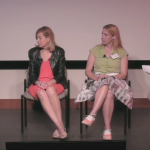From the Cronkite Journalism School in Phoenix…
… I’m writing this is one of the classrooms before giving my talk about “Deep Search,” which is pretty much what the topic of SearchResearch is all about. It’s a fascinating time to reflect on the connections between what we talk about here, and what I think people need to know to be effective searchers. More on this later…
Right now, let’s solve last week’s Challenge.
1. This wallpaper showed up recently on my Android device; I was struck by how beautiful it is. Can you figure out where this in on our planet? What’s the lat/long? (There’s no metadata here, I already checked.)
First of all, excellent SearchResearch skills by the team! You collectively solved it in less than 24 hours. This was a pretty difficult challenge, so I’m very impressed.
As I mentioned, I saw this first as wallpaper on my Android device. As it turns out, I asked a fellow Googler about this, and he took the Challenge and found it pretty quickly! Impressed, I asked him how he did it. He wrote back to say:
I manually searched on Google Earth. I was able to make some assumptions about where to look from details in the original image, but then I basically followed a hierarchical linear search of likely coastlines. I was able to cover most of Africa in a few minutes by zooming in and out along the coastline and skipping obvious jungles, deserts, and mountains.
When it wasn’t there, I considered other possibilities and rapidly discarded them (the non-straight, unpaved roads and irregular field shapes really rules out places that have the right potential geography but are even moderately affluent, like parts of South America or Australia — the roads are all straight along the coast if the ground is flat, and the fields are quite regular).
That left very few possibilities (basically just Madagascar once you recognize that most other places that are likely to have that kind of roads in flat areas are all jungles). In all, it took less than 10 minutes (describing the process in this email was slower).
In other words, he recognized that the image has certain properties: it’s got a characteristic field layout, the coast runs roughly NW-to-SE (at around -30 degrees), and that it’s clearly in the 3rd world. By quickly scanning plausible places (in the tropics) at a 30,000 foot elevation (or 10 km height), he was able to spot the characteristic reddish color and the angle of the coastline.
Interestingly, I didn’t really believe him about this, so I started looking around with Google Earth as well, and much to my surprise, I too was able to find it with not-quite-manual search, but informed searches of our planet.
I estimated the size of the photo as being about 3 miles across, so I wanted to start scanning in roughly 3 mile chunks of coastline that was largely red, rural, and trending NW-to-SE.
I know the world is a big place, but if you look at Africa (this is from Google Maps in Earth view mode), you’ll see that there actually aren’t that many places to look that will match this description:
Only portions of South Africa, Nigeria, and Madagascar look plausible. A quick check of those places shows that only Madagascar makes any kind of sense. Now you could say, “wait a second, there’s a LOT more to the world than this!” But keep in mind you only need to check from pretty far up–you can literally skim the maps at a high “altitude” — like this:
At this height, we can look at very large swathes of continents for plausible places. It’s clear only the southern end of Madagascar is plausible. If you zoom in a bit more:
Here I added the dashed rectangle to show a plausible region on the coast, and the red/white bars to indicate 10-mile segments. As this altitude, you can scan around 145 miles of coastline in a couple of seconds. It doesn’t take long to look at only the coastlines that are at the correct angles (and land color). This is 145 mile wide section, only the part in the box makes any sense to zoom in. And when you do, this is what you see:
This is at -25.1684274,46.535719 (LINK to Map), and obviously the right place. (Not quite the same color, but with a little shopping, we could get it to be pretty darn close. (If you check the wave breaks side-by-side, you’ll see it’s really the same image.
2. Some animals have the ability to grow body parts back when they lose them. Some lizards, for instance, can regrow a lost tail; some salamanders can grow back a leg. But SOME animals don’t grow the missing body part back, but reorganize their body plan. What’s this process called? What kind of animal can do this?
I didn’t realize this would be quite so easy. The obvious query:
[ reorganize body after losing part ]
gives an article about symmetrization, which is the ability of some animals (such as jellyfish) to regrow body parts that have been lost (either through natural causes, like a turtle bite, OR a biologist cutting off bits). A paper describing this process (and from which the photo below is taken) is Self-repairing symmetry in jellyfish through mechanically driven reorganization.
(M. Abrams, et al., Proc. National Academy of Sciences, vol. 112 no. 26, doi: 10.1073/pnas.1502497112)
 |
| From left to right, the process of jellyfish symmetrization, starting with the amputated state. Image Credit:Michael Abrams, Ty Basinger, and Christopher Frick, California Institute of Technology |
The trick here is that unlike salamanders , which can regrow amputated limbs, the jellyfish has to regrow a LOT of its body, which means continually reorganization. Impressive. Wish I could do that.
3. I ran across this great word Mbaqanga, and I know it refers to a particular kind of music. But WHAT kind of music is this? And… how in the heck do you pronounce that word?










